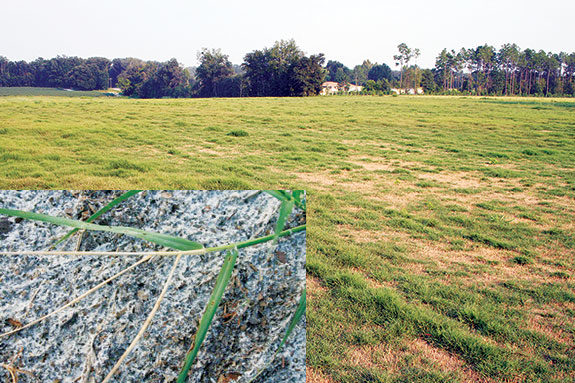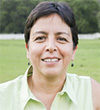Some of these reports are based on expected decline – where loss is directly associated with aging or mismanagement, typically overstocking – but many others are the product of extremes in weather conditions.
Under such stresses forage plants become vulnerable to opportunistic pest and pathogens present in the soil or the environment.
Because plants are immobile they cannot escape the herbivores that eat them, whether they are livestock or insect pests or the microorganisms that cause plant diseases; therefore, the importance of proper management when in presence of a weakened stand.
The first group, decline due to aging, is easier to identify because the loss can be attributed to the expected progression of a natural process. And you might be suspecting that it is already time to renovate that 30+ years-old field which has been dropping production. However, the second group requires a more exhaustive examination for proper management moving forward.
To many it will be startling to know that popular bermudagrass cultivars currently in use were in fact released for commercial use over 50 years ago (Coastal was released in 1943, Midland in 1953, Giant in 1957).
If you know your stand has dwindled production and you know it was planted a few decades ago, it may be time to renovate.
I would like to focus on that second group where decline is occurring and the stand is not older than two, three or five years.
In these cases we could be facing one or a combination of the following situations: mismanagement (overgrazing), cool-season/warm-season forage competitions or injured stands due to weather stresses and opportunistic disease-causing microorganism/pest complex interactions that attack weakened stands.
1. Overstocking/low stubble height
Because grazing is usually the least expensive way of feeding livestock, it can be easily abused. Routine overstocking or harvesting to a very low stubble height leads to post-grazing or post-harvesting stubble heights that compromise the reserve status of plants.
In order to produce regrowth and regenerate the new leaves, the plant needs to have tissue that has not been grazed or cut. If we don’t leave sufficient leaves, the plant will use the reserves (or stored carbohydrates) present in the root system to grow back the new tissue, leading to a shrunk root system.
Under heavier grazing, cold winter, prolonged drought and lower light, the reserves below ground become more critical for the long-term recovery of the stand.
The larger the root system, the better – there will be more soil area explored for nutrients and water. Stocking or cutting to a conservative height making sure you leave sufficient stubble (“a tint of green”) aids recovery of the plant and replenishing of plant reserves in stem and crown tissues.
2. Cool-season/warm-season competition (bermudagrass/annual ryegrass competition)
In this case, the stand is under the direct shading effect imposed by the cool-season grass, which over time weakens the emerging warm-season grass.
The spring of the year is a critical time because in many cases, particularly in warm winters, the perennial warm-season grass comes out of dormancy when the bulk of production of cool-season grass such as annual ryegrass occurs.
It can be regarded as a shading effect given the high requirements for light by warm-season perennial grasses.
In these cases, it is recommended to remove the shade conditions by keeping the pasture or field well grazed without overstocking or using a higher frequency of harvest if cutting the cool-season grass hay.
Alternatively, chemically remove the cool-season while the warm-season is dormant; by killing the entire plant, this option eliminates the competition for light as well as water and nutrients.
3. Weather/pest interactions
The weather conditions of the last several years have been marked by extreme patterns throughout most pastures and forage crop-producing areas. These extremes seem to be the norm rather than the exception.
The scenario includes a seasonal sequence of cold winter, oscillating cold/warm spring and hot/humid summers.
• Cold winter with frequent freezing events, if extreme, could damage the root of warm-season forage plants.
• Sudden cold/warm temperature changes in spring create conditions of warm temperatures above ground but cold soil below ground.
In this case, the warm-season forage plants experience above-ground day temperatures in the mid-70°F that signal production while the soil is still cold (below 50-55°F) and plants are dormant with little root activity.
• Lower spring rainfall than in summer that does not support the stimulation of above-ground leaf production.
• Hot and humid summer, ideal for fungal diseases to spread and weaken plants.
The reports associated with these stress conditions include yellowing, thinning and dying patches. These losses reduce yield, quality and longevity of the stand.
They are difficult to detect because the source of the loss, in many cases, occurs below ground where they attack the root system, but the expression of damage is in the new leaves.
In many cases, these symptoms may be compounded or masked with damage from insect pests laying eggs on damaged tissue originating from soil pathogens.
Under this situation of weather/pest interactions, short-term management guidelines include:
• Cutting or reducing nitrogen fertilization when yellowing symptoms occur (because it may be related to the presence of certain diseases causing microorganism and not nitrogen deficiency). If facing a plant disease (of fungal origin), the nitrogen usually fuels the pathogen.
• Taking a soil and tissue test to make sure you are providing the adequate nutrients to the plant, and to diagnose the causal agent.
• Graze or cut and bale to stop the plunge in quality.
• If aerating, disinfect tines.
Longer-term management guidelines to strengthen the root system and plant include:
• Use bermudagrass varieties adapted to your area and latitude. If in a northern latitude, use some of the varieties that have more cold tolerance.
• Build up soil organic matter and fertility.
• Use conservative stocking and leave sufficient stubble height. FG
PHOTOS
These pictures show the damage (yellow patches) to grass by soil-borne fungi ‘Take All’ root rot (Gaeumannomyces graminis) in a bermudagrass field in north-central Florida. Notice the damage of the new leaves – an obvious white (see inset). Photos courtesy of Yoana Newman.










